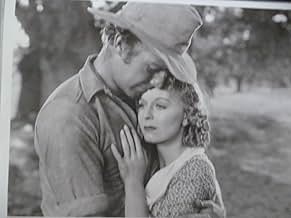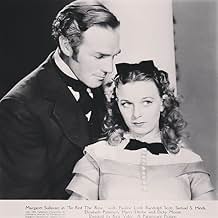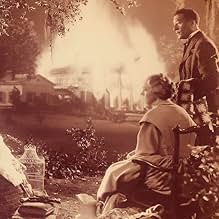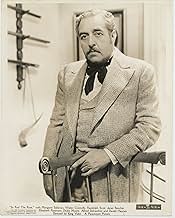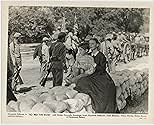Ajouter une intrigue dans votre langue"So Red the Rose" is King Vidor's quietly-affecting Civil War romance starring Margaret Sullavan as a Southern aristocrat, the mistress of a Southern plantation, whose sheltered life is torn... Tout lire"So Red the Rose" is King Vidor's quietly-affecting Civil War romance starring Margaret Sullavan as a Southern aristocrat, the mistress of a Southern plantation, whose sheltered life is torn apart by the War between the States. During the war's darkest days she is sustained by he... Tout lire"So Red the Rose" is King Vidor's quietly-affecting Civil War romance starring Margaret Sullavan as a Southern aristocrat, the mistress of a Southern plantation, whose sheltered life is torn apart by the War between the States. During the war's darkest days she is sustained by her love for a distant cousin, a Confederate officer played by Randolph Scott.
- Réalisation
- Scénario
- Casting principal
- Confederate Officer
- (non crédité)
- Cavalry Captain
- (non crédité)
- Slave
- (non crédité)
Avis à la une
No, this movie isn't in Technicolor, there's no tearjerker theme, and the running time is half that of the famous epic, but it's still very similar. I'm not a Margaret Sullavan fan, but she's just fine in this role. Randolph Scott is, of course, perfect. Walter Connolly, a highly underrated actor with too brief a career, added to the believability of the film. If you love Gone With the Wind, I really wouldn't recommend renting this version. It won't change your mind, since it's obviously a lesser quality movie. But if you always feel frustrated every time you hear Clark Gable speak without a Southern accent, this movie will help vindicate you.
In "So Red the Rose", the black slaves (especially the house slaves) are super-loyal and decent and it's only the wicked field hands that become 'uppity' towards the end of the Civil War. The message seems to be that without the war, everything would have just been fine!
As far as the story goes, it's all about a rich antebellum family, the Bedfords. While the womenfolk stay home, the men are out giving their all for the South. It's all told in a highly sympathetic and melodramatic fashion...with lots of sweet music, tenderness and style. And, when the war is over the blacks are no longer slaves and are rebellious and ungrateful for the wonderful treatment they'd received from their owners!!
The bottom line is that this film is very slickly made and well acted...and complete crap! I do not understand how so many reviewers loved the film and didn't seem to notice that it was also a complete lie. Strange.
The one moment that does stand out (and stands out against the normal racist rubbish of the 1930s) was when Sullivan confronts her slaves, who have heard the Yankee troops are approaching and they may be free. She tries to control them with reminders of how good her family was to them (although - tellingly - she slaps one who dare suggests its wasn't all that great). But further bad news reaches her, and she collapses. The slaves look at her - and walk away to desert the plantation. No scene like that is in GWTW, but I suspect it happened far more frequently than Margaret Mitchell would have preferred to have know of.
Like GWTW there is precious little action - one would expect a Civil War picture to have some second unit action, but no. The most we get are a few loud arguments, mostly from Miss Sullavan who is the pivotal figure in the film as Vivien Leigh was in hers. It is mainly a character study with a good, solid story to go with it. There is a sequence in which the slaves of the Bedford's realize they are free, but can't figure out what to do about it. I found it fascinating and gives one pause as to what it must have been like to suddenly find yourself a free man after a lifetime of slavery. This is the type of situation that a master director like King Vidor can bring off - a completely human instance tailor-made for him and which he illustrated in "The Crowd"(1928).
This is a good movie and a good story. I thought it had some touches that GWTW did not - what it doesn't have is length (at only 80 minutes), scope and a PR campaign behind it like the more famous film. But it is well worth seeing in its own right.
Le saviez-vous
- AnecdotesOne of over 700 Paramount Productions, filmed between 1929 and 194; its, which were sold to MCA/Universal in 1958 for television distribution, and have been owned and controlled by Universal ever since; its earliest documented telecast took place in Seattle Tuesday 24 March 1959 on KIRO (Channel 7); it first aired in Boston 6 December 1959 on WBZ (Channel 4).
- GaffesAt about 52 mins, a pickup truck can be seen driving slowly in the distance, followed by a horse-drawn vehicle.
- ConnexionsFeatured in Black Shadows on a Silver Screen (1975)
Meilleurs choix
Détails
- Date de sortie
- Pays d’origine
- Langue
- Aussi connu sous le nom de
- So Red the Rose
- Lieux de tournage
- Société de production
- Voir plus de crédits d'entreprise sur IMDbPro
- Durée
- 1h 22min(82 min)
- Couleur
- Rapport de forme
- 1.37 : 1

